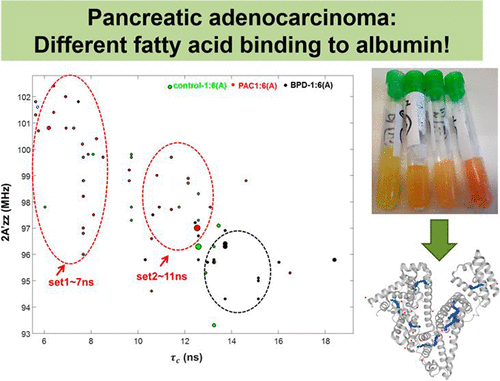当前位置:
X-MOL 学术
›
ACS Pharmacol. Transl. Sci.
›
论文详情
Our official English website, www.x-mol.net, welcomes your
feedback! (Note: you will need to create a separate account there.)
Identification of Patients with Pancreatic Cancer by Electron Paramagnetic Resonance Spectroscopy of Fatty Acid Binding to Human Serum Albumin
ACS Pharmacology & Translational Science ( IF 4.9 ) Pub Date : 2020-10-01 , DOI: 10.1021/acsptsci.0c00116 Haleh H Haeri 1 , Jörg Tomaszewski 2 , Bettina Phytides 2 , Heike Schimm 1 , Gabriela Möslein 3 , Marco Niedergethmann 2 , Dariush Hinderberger 1 , Marcos Gelos 3
ACS Pharmacology & Translational Science ( IF 4.9 ) Pub Date : 2020-10-01 , DOI: 10.1021/acsptsci.0c00116 Haleh H Haeri 1 , Jörg Tomaszewski 2 , Bettina Phytides 2 , Heike Schimm 1 , Gabriela Möslein 3 , Marco Niedergethmann 2 , Dariush Hinderberger 1 , Marcos Gelos 3
Affiliation

|
An effective biological marker for pancreatic adenocarcinoma (PAC) is not available so far. Here, we investigate how electron paramagnetic resonance (EPR) spectroscopy of spin-labeled fatty acid (FA) molecules binding to human serum albumin (HSA) in human serum is a suitable method for the identification of patients with PAC through detection of PAC-induced changes of FA binding to albumin. The functionality of HSA to bind FA is investigated in serum samples of 35 patients with PAC, 26 patients with benign pancreatic tumors (BPD), and 24 healthy individuals by continuous wave (CW) EPR spectroscopy by simply dissolving 16-DOXYL stearic acid as spin-labeled FA. It is found that FA binding to HSA in PAC is significantly modified when compared with healthy and BPD individuals. The PAC group could best be discriminated from the healthy group based on EPR characteristics at the loading ratio of 1:4 (HSA:FA), while patients with PAC and BPD are distinguishable at a loading ratio of 1:6. Using nanoscale distance measurements through double electron–electron resonance (DEER), it is found that the distribution of FAs in the HSA of one PAC patient is similar to that of FAs in healthy individuals. Combining all EPR spectroscopic data, this leads to a tentative molecular interpretation of only small changes in hydration at the protein’s surface as origin of the detectable characteristics for PAC patients. Thus, EPR of FA/HSA binding is a simple and promising tool for clinical detection of patients with PAC and needs to be tested with larger ensembles of different patient groups.
中文翻译:

通过脂肪酸与人血清白蛋白结合的电子顺磁共振光谱识别胰腺癌患者
迄今为止,还没有胰腺腺癌 (PAC) 的有效生物标志物。在这里,我们研究了与人血清中人血清白蛋白 (HSA) 结合的自旋标记脂肪酸 (FA) 分子的电子顺磁共振 (EPR) 光谱如何通过检测 PAC 诱导的FA 与白蛋白结合的变化。在 35 名 PAC 患者、26 名良性胰腺肿瘤 (BPD) 患者和 24 名健康个体的血清样品中,通过简单地溶解 16-DOXYL 硬脂酸作为自旋,通过连续波 (CW) EPR 光谱研究了 HSA 结合 FA 的功能-标记的 FA。发现与健康和 BPD 个体相比,PAC 中 FA 与 HSA 的结合显着改变。PAC 组在负荷比为 1:4 (HSA:FA) 时可以根据 EPR 特征与健康组区别开来,而在负荷比为 1:6 时可以区分 PAC 和 BPD 患者。通过双电子-电子共振 (DEER) 使用纳米级距离测量,发现一名 PAC 患者的 HSA 中 FA 的分布与健康个体中 FA 的分布相似。结合所有 EPR 光谱数据,这导致对作为 PAC 患者可检测特征的起源的蛋白质表面水合的微小变化的初步分子解释。因此,FA/HSA 结合的 EPR 是一种用于临床检测 PAC 患者的简单而有前途的工具,需要在不同患者组的更大集合中进行测试。FA),而 PAC 和 BPD 患者在负荷比为 1:6 时是可区分的。通过双电子-电子共振 (DEER) 使用纳米级距离测量,发现一名 PAC 患者的 HSA 中 FA 的分布与健康个体中 FA 的分布相似。结合所有 EPR 光谱数据,这导致对作为 PAC 患者可检测特征的起源的蛋白质表面水合的微小变化的初步分子解释。因此,FA/HSA 结合的 EPR 是一种用于临床检测 PAC 患者的简单而有前途的工具,需要在不同患者组的更大集合中进行测试。FA),而 PAC 和 BPD 患者在负荷比为 1:6 时是可区分的。通过双电子-电子共振 (DEER) 使用纳米级距离测量,发现一名 PAC 患者的 HSA 中 FA 的分布与健康个体中 FA 的分布相似。结合所有 EPR 光谱数据,这导致对作为 PAC 患者可检测特征的起源的蛋白质表面水合的微小变化的初步分子解释。因此,FA/HSA 结合的 EPR 是一种用于临床检测 PAC 患者的简单而有前途的工具,需要在不同患者组的更大集合中进行测试。发现一名 PAC 患者的 HSA 中 FA 的分布与健康个体中 FA 的分布相似。结合所有 EPR 光谱数据,这导致对作为 PAC 患者可检测特征的起源的蛋白质表面水合的微小变化的初步分子解释。因此,FA/HSA 结合的 EPR 是一种用于临床检测 PAC 患者的简单而有前途的工具,需要在不同患者组的更大集合中进行测试。发现一名 PAC 患者的 HSA 中 FA 的分布与健康个体中 FA 的分布相似。结合所有 EPR 光谱数据,这导致对作为 PAC 患者可检测特征的起源的蛋白质表面水合的微小变化的初步分子解释。因此,FA/HSA 结合的 EPR 是一种用于临床检测 PAC 患者的简单而有前途的工具,需要在不同患者组的更大集合中进行测试。
更新日期:2020-10-01
中文翻译:

通过脂肪酸与人血清白蛋白结合的电子顺磁共振光谱识别胰腺癌患者
迄今为止,还没有胰腺腺癌 (PAC) 的有效生物标志物。在这里,我们研究了与人血清中人血清白蛋白 (HSA) 结合的自旋标记脂肪酸 (FA) 分子的电子顺磁共振 (EPR) 光谱如何通过检测 PAC 诱导的FA 与白蛋白结合的变化。在 35 名 PAC 患者、26 名良性胰腺肿瘤 (BPD) 患者和 24 名健康个体的血清样品中,通过简单地溶解 16-DOXYL 硬脂酸作为自旋,通过连续波 (CW) EPR 光谱研究了 HSA 结合 FA 的功能-标记的 FA。发现与健康和 BPD 个体相比,PAC 中 FA 与 HSA 的结合显着改变。PAC 组在负荷比为 1:4 (HSA:FA) 时可以根据 EPR 特征与健康组区别开来,而在负荷比为 1:6 时可以区分 PAC 和 BPD 患者。通过双电子-电子共振 (DEER) 使用纳米级距离测量,发现一名 PAC 患者的 HSA 中 FA 的分布与健康个体中 FA 的分布相似。结合所有 EPR 光谱数据,这导致对作为 PAC 患者可检测特征的起源的蛋白质表面水合的微小变化的初步分子解释。因此,FA/HSA 结合的 EPR 是一种用于临床检测 PAC 患者的简单而有前途的工具,需要在不同患者组的更大集合中进行测试。FA),而 PAC 和 BPD 患者在负荷比为 1:6 时是可区分的。通过双电子-电子共振 (DEER) 使用纳米级距离测量,发现一名 PAC 患者的 HSA 中 FA 的分布与健康个体中 FA 的分布相似。结合所有 EPR 光谱数据,这导致对作为 PAC 患者可检测特征的起源的蛋白质表面水合的微小变化的初步分子解释。因此,FA/HSA 结合的 EPR 是一种用于临床检测 PAC 患者的简单而有前途的工具,需要在不同患者组的更大集合中进行测试。FA),而 PAC 和 BPD 患者在负荷比为 1:6 时是可区分的。通过双电子-电子共振 (DEER) 使用纳米级距离测量,发现一名 PAC 患者的 HSA 中 FA 的分布与健康个体中 FA 的分布相似。结合所有 EPR 光谱数据,这导致对作为 PAC 患者可检测特征的起源的蛋白质表面水合的微小变化的初步分子解释。因此,FA/HSA 结合的 EPR 是一种用于临床检测 PAC 患者的简单而有前途的工具,需要在不同患者组的更大集合中进行测试。发现一名 PAC 患者的 HSA 中 FA 的分布与健康个体中 FA 的分布相似。结合所有 EPR 光谱数据,这导致对作为 PAC 患者可检测特征的起源的蛋白质表面水合的微小变化的初步分子解释。因此,FA/HSA 结合的 EPR 是一种用于临床检测 PAC 患者的简单而有前途的工具,需要在不同患者组的更大集合中进行测试。发现一名 PAC 患者的 HSA 中 FA 的分布与健康个体中 FA 的分布相似。结合所有 EPR 光谱数据,这导致对作为 PAC 患者可检测特征的起源的蛋白质表面水合的微小变化的初步分子解释。因此,FA/HSA 结合的 EPR 是一种用于临床检测 PAC 患者的简单而有前途的工具,需要在不同患者组的更大集合中进行测试。











































 京公网安备 11010802027423号
京公网安备 11010802027423号